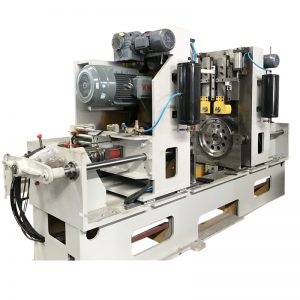The seam welding machine is mainly assembled with weldments to form a lap joint or a butt joint, and placed between the electrodes of the two rollers, and the electrodes of the rollers are pressure welded to make them rotate. Perform continuous or indirect pulse loose power transfer mode. This will create a resistance welder with a continuous weld.
1. Seam welding and spot welding are the combination of heat (force) in the same welding process. In contrast, the mechanical (force) effect during the welding process is insufficient (no flat seam welding), and the faster the welding speed, the more obvious the performance.
2. Seam welding is composed of overlapping welding points, so the shunt during welding is more serious than spot welding, which makes it difficult to weld thick plates of high-conductivity aluminum alloys and magnesium alloys.
3. Adhesion damage is prone to occur on the surface of the roll, and the surface quality of the weld is deteriorated, so this is a special problem for trimming.
4. Since the cross-sectional area of seam welding is usually more than twice the longitudinal load area of the base material (the thinner the plate, the smaller the ratio error), the area of damage to the base material must occur under the influence of heat. Therefore, the seam welded structure pays little attention to the strength of the joint, and first requires good sealing and corrosion resistance.


During the seaming process, each solder joint also undergoes three stages of pre-compression, electric heating and cooling crystallization. However, due to the rapid change in relative orientation between the roller and the weldment during seam welding. The working method of the welding machine is based on the electromechanical matching method, that is, the rotation of the roller (the movement of the welding part) and the passage of the welding current (electricity), the roller rotates continuously, the welding part moves at a stable speed, the welding current passes continuously, and every half The loop constitutes a solder joint. The welding speed can reach 10~20m/min. Practical use is limited due to the poor quality of the welded surface. During intermittent seam welding, the weldment moves continuously at a stable speed, and the welding current passes alternately, each time “according to the thickness of the plate, the welding speed is 0.5~4.3m/min. It is widely used in the primary production of ferrous metals, water, and oil seal welds .
